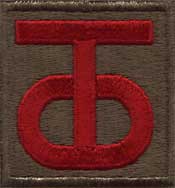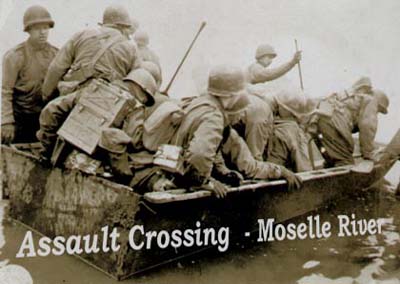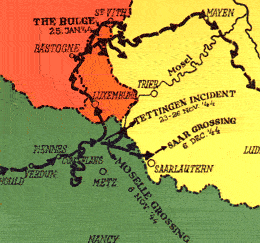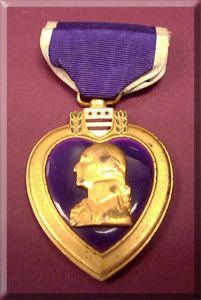



On the 8th of November, the 358th Regiment assembled in secrecy on the west bank of the Moselle River near Cattenom not far from the border with Germany. By daylight of the following day the battalion had crossed the river in assault boats, and begun the attack on the enemy's river defense. At the same time, the Germans woke up and plastered the entire river line with all the artillery they could muster.
 The
situation fast became critical. On the east bank of the river there were no
vehicles, and all supplies were hand carried to to the fighting men on the
line. Meanwhile, the once serene and peaceful Moselle broke into a raging
torrent whose flood waters threatened to overrun the entire landscape. Intense
enemy artillery fire inflicted numerous casualties on the troops and prevented
the construction of a bridge almost as much as did the raging river.
The
situation fast became critical. On the east bank of the river there were no
vehicles, and all supplies were hand carried to to the fighting men on the
line. Meanwhile, the once serene and peaceful Moselle broke into a raging
torrent whose flood waters threatened to overrun the entire landscape. Intense
enemy artillery fire inflicted numerous casualties on the troops and prevented
the construction of a bridge almost as much as did the raging river.
Finally, the long fight against the mighty Moselle River ended when, on the sixth day the bridge was completed and vehicles and guns rolled across to the beleagured Regiment on the other side.
 Saar
River: At a quater past
four on the morning of the 6th of December, the Third Battalion, led by I
Company and L Company scrambled down the steep banks near Oberlimberg, Germany
and quietly loaded into assault boats, and made its way across the Saar River.
The Second Battalion, crossing after daylight faced heavy mortar and machine
gun fire from enemy pillboxes commanding the river line. Once
across the battalions faced the fortified cities of Pachten and Dilligen,
bulwarks of the Siegfried Line.
Saar
River: At a quater past
four on the morning of the 6th of December, the Third Battalion, led by I
Company and L Company scrambled down the steep banks near Oberlimberg, Germany
and quietly loaded into assault boats, and made its way across the Saar River.
The Second Battalion, crossing after daylight faced heavy mortar and machine
gun fire from enemy pillboxes commanding the river line. Once
across the battalions faced the fortified cities of Pachten and Dilligen,
bulwarks of the Siegfried Line.
 The
main thouroughfares took on the names like "88 Street" and "Purple Heart Avenue."
It became a war against steel and concrete. Troops were raked by fire from
pillboxes cleverly concealed in harmless looking barns and shops. For sixteen
days and nights the battalions hit again and again into the enemy's fortifications.
Continuously hammered day after day, the enemy was systematically blown out
of one pillbox after another, as all three Battalions were employed to clear
the major portion of Dilligen.
The
main thouroughfares took on the names like "88 Street" and "Purple Heart Avenue."
It became a war against steel and concrete. Troops were raked by fire from
pillboxes cleverly concealed in harmless looking barns and shops. For sixteen
days and nights the battalions hit again and again into the enemy's fortifications.
Continuously hammered day after day, the enemy was systematically blown out
of one pillbox after another, as all three Battalions were employed to clear
the major portion of Dilligen.
Then one day came the startling news of the great German counteroffensive
in the Ardennes - The Battle of the Bulge. On December 21st, the 90th Division
withdrew across the Saar, forsaking its sizeable dent in the Siegfried Line
and moved to a defensive position in the Saar-Moselle triangle facing the
Siegfried Line again. The holidays were days of patrolling and constant alert
for unusual enemy activity. Tanks and artillery helped-but GI guts and fighting
skill cracked the Siegfried Line. Until the 22nd of February the Battle of
the Siegfried Line was a pillbox to pillbox job.
From here it was a ratrace to the Rhine, with the Third Battalion covering
an average of 25 miles a day.
Editor's Note: Pvt. Eldridge Bragg was wounded by a mortar shell on January 13, 1945 near Braas, Belgium.